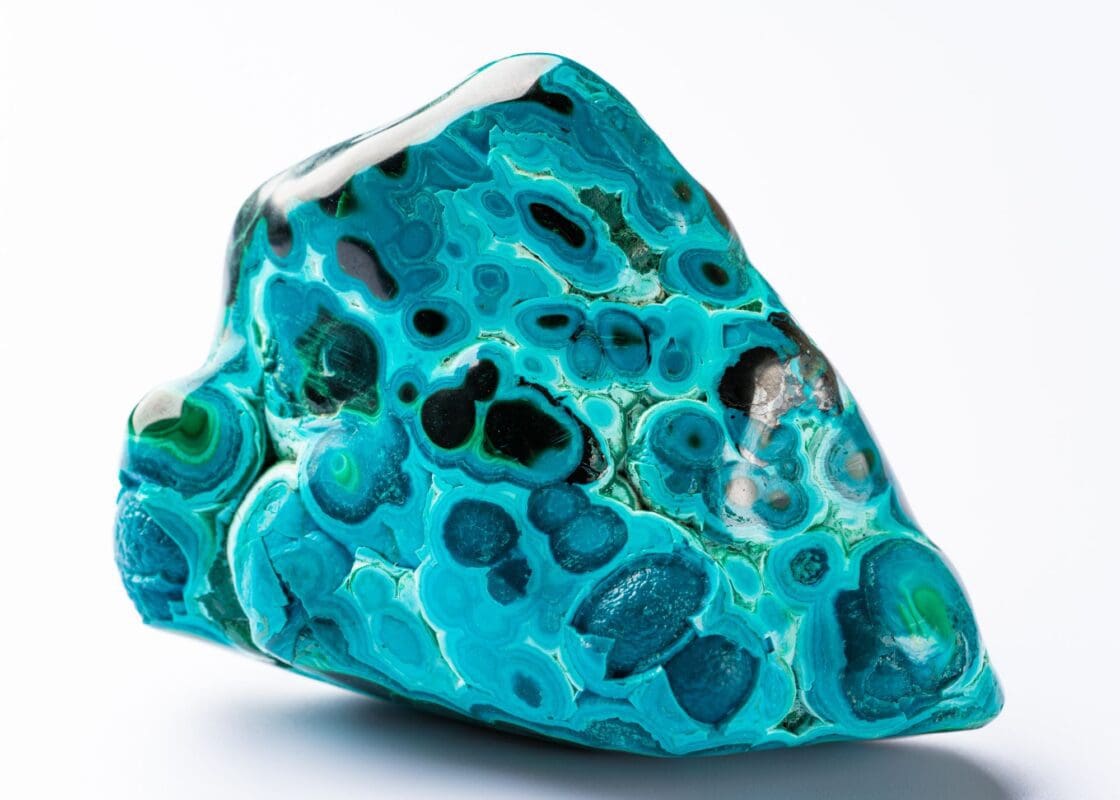Chrysocolla: The Captivating Gemstone with Healing Powers
Introduction
Have you ever marveled at the serene beauty of Chrysocolla, a gemstone known for its captivating blue-green hues that evoke the tranquility of the sea and sky? This striking stone, with its unique combination of color and form, has been a source of fascination and admiration in gemstone collections worldwide. In this article, we will explore the allure and historical richness of Chrysocolla, a gemstone as captivating in its beauty as it is profound in its historical significance.
Historical Significance of Chrysocolla
Chrysocolla’s journey through history is as colorful as the stone itself. Used by ancient civilizations, such as the Egyptians and Greeks, Chrysocolla was revered not only for its beauty but also for its supposed healing and protective powers. In many cultures, it was considered a stone of wisdom, peace, and empowerment, often associated with goddesses and revered for its feminine energy. This historical connection has made Chrysocolla a symbol of expression, teaching, and compassion through the ages.
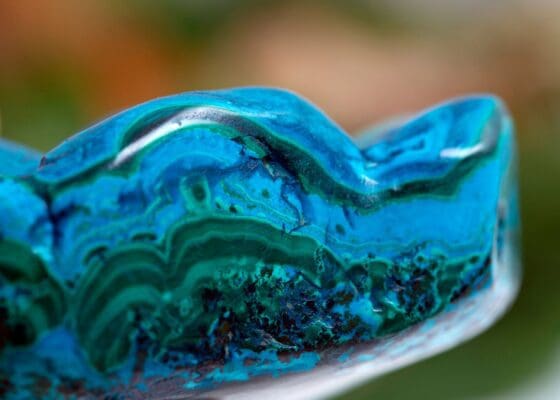
Geological Formation and Properties of Chrysocolla
Chrysocolla typically forms in the oxidized zones of Copper ore bodies, where it is often found alongside minerals such as malachite, azurite, and quartz. This mineral’s formation process contributes to its unique appearance, with colors ranging from soft, sky blue to vibrant shades of turquoise and green, often intermingled in captivating patterns.
Physical Properties: Chrysocolla is known for its alluring blue-green color, which can vary in hue and intensity. It’s often found in a matrix with other minerals, which can add to its aesthetic appeal. The stone is relatively soft, ranking between 2.5 and 3.5 on the Mohs hardness scale, making it a delicate choice for jewelry.
The Healing and Metaphysical Properties of Chrysocolla
Chrysocolla’s Healing Benefits: Chrysocolla is renowned in the world of healing crystals for its calming and soothing properties. It is believed to aid in the expression of emotions and thoughts, making it a popular choice for those seeking emotional balance. Many practitioners use Chrysocolla to alleviate stress, anxiety, and fear, attributing to it the power to bring about gentle release and tranquility.

Metaphysical Properties: Metaphysically, Chrysocolla is associated with the throat and heart chakras. It is said to enhance communication, especially in situations requiring truth and wisdom. The stone is also thought to empower feminine energies, encouraging compassion, kindness, and patience.
Role in Modern Holistic Practices: In contemporary wellness circles, Chrysocolla is used for meditation, reiki, and energy work. Its presence is believed to enhance mindfulness and spiritual connection, making it a favored stone among healers and spiritual seekers.
Chrysocolla in Jewelry and Decorative Arts
Usage in Jewelry Making: Chrysocolla’s striking blue-green hues make it a popular choice for jewelry. It is often set in silver or copper to complement its color palette. The stone is typically cut into cabochons or used as beads in necklaces and bracelets. Its relative softness requires careful handling and setting to preserve its integrity.
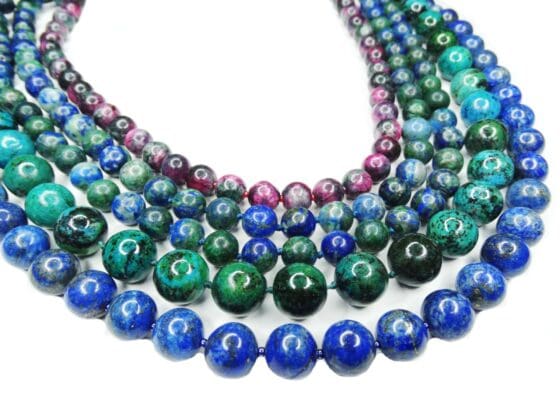
Popular Styles and Designs: Chrysocolla jewelry often features a bohemian or earthy style, highlighting the stone’s natural beauty. Artisans may pair it with other gemstones or set it alone as a statement piece. In decorative arts, Chrysocolla is used for inlays, small sculptures, and ornamental objects, prized for its vibrant color and unique patterns.
Collecting Chrysocolla
Value in the Collector’s Market: Chrysocolla is valued by collectors for its color, patterns, and association with Copper-bearing minerals. High-quality specimens, especially those with distinct and vibrant coloration or those found in unique combinations with minerals like malachite or quartz, are particularly sought after.
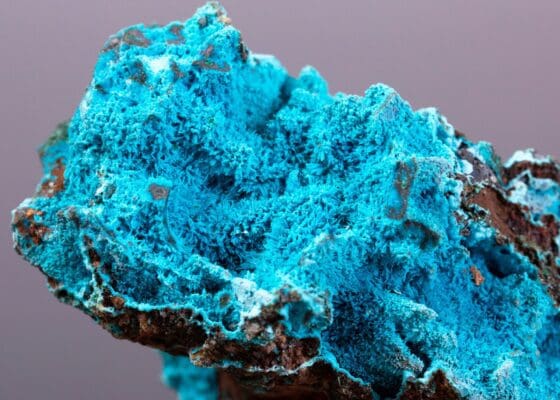
Tips for Collecting: When collecting Chrysocolla, consider the color intensity and the presence of other complementary minerals that might enhance its appeal. Due to its softness, the condition of the specimen is crucial – well-preserved pieces without significant wear or damage are more desirable. Understanding its geological origin can also add to a collector’s appreciation of each specimen.
Major Locations and Mining of Chrysocolla
Locations Where Chrysocolla Is Found or Mined: Chrysocolla, known for its captivating blue-green hues, is primarily mined in regions rich in copper deposits. Key locations include:
- Chile and Peru: These South American countries are known for their vast copper mines, where Chrysocolla is often found as a secondary mineral.
- Democratic Republic of Congo: The copper belt in this region yields high-quality Chrysocolla, frequently found alongside malachite and azurite.
- United States: Arizona, known for its extensive copper mining history, has several mines where Chrysocolla is extracted. The state’s Morenci and Globe-Miami districts are notable sources.
- Russia: The Gumeshevskoye copper deposit in the Ural Mountains is another significant source of Chrysocolla.
- Australia: Regions in Western Australia and Queensland have copper mines that produce Chrysocolla as a byproduct.
Public Gem Mining Information: While large-scale commercial mines are the primary sources of Chrysocolla, there are opportunities for enthusiasts to experience gem mining on a smaller scale. Some public mines and pay-to-dig sites offer the chance to search for various minerals, including Chrysocolla. These sites provide a hands-on experience for those interested in geology and mineral collection. However, it’s important to note that Chrysocolla may not be as commonly found in public mines as some other minerals, so researching specific locations known for their Chrysocolla deposits is recommended before planning a visit.
Caring for and Maintaining Chrysocolla
Best Practices for Preservation: Chrysocolla, being a relatively soft mineral (2.5-3.5 on the Mohs scale), requires careful handling to maintain its vibrant colors and structure. Avoid exposing it to harsh chemicals, extreme temperatures, and direct sunlight, which can cause fading or damage.
Cleaning Tips: To clean Chrysocolla, use lukewarm water and a mild soap. Gently wipe the surface with a soft cloth or a soft brush. Avoid ultrasonic cleaners and steam cleaning, as these can cause harm to the stone. After cleaning, dry it thoroughly with a soft cloth.

Storing Chrysocolla Jewelry and Artifacts: Store Chrysocolla jewelry in a separate pouch or box to prevent scratches from harder stones. Keep it away from high humidity areas to prevent any potential water damage. For artifacts, display them in a stable environment away from direct sunlight and dust.
Chrysocolla Imitations and Authenticity
Identifying Genuine Chrysocolla: Authentic Chrysocolla has a distinctive blue-green color, often intermixed with other minerals like quartz or malachite, which can give it a unique appearance. Its hardness and specific gravity can also be indicators of authenticity.
Prevalence of Imitations: Due to its popularity, the market does see its share of fake Chrysocolla, often made from dyed agates or other less valuable blue-green minerals. Some imitations may also be composites made from crushed Chrysocolla mixed with resins.
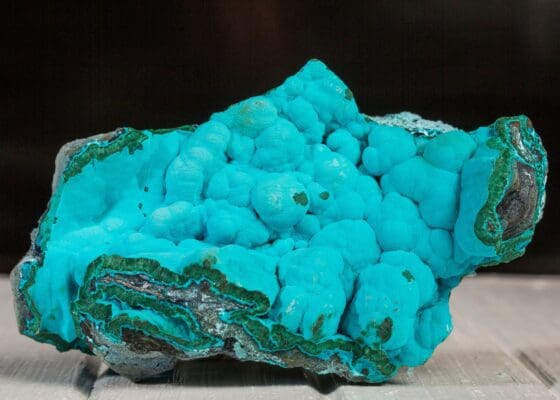
Authenticity Tests: Conducting a scratch test (testing the hardness) can help determine authenticity. However, for a more accurate assessment, especially for valuable pieces, consulting with a gemologist or having the piece evaluated in a reputable laboratory is recommended.
Market Value and Rarity of Chrysocolla
Market Value Analysis: The value of Chrysocolla can vary significantly based on its quality and the presence of other complementary minerals. Pure, vibrant blue-green specimens with minimal impurities tend to be more valuable.
Factors Influencing Price: Color intensity, pattern, size, and overall aesthetics play a significant role in determining Chrysocolla’s value. The presence of matrix or other minerals can either enhance or detract from its value, depending on the specimen’s visual appeal.
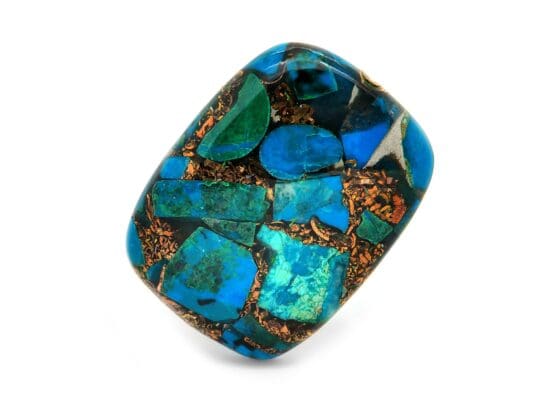
Rarity and Value: Pure Chrysocolla is relatively rare, making it valuable to collectors. Specimens that display an exceptional color or are part of an aesthetically pleasing mineral matrix are especially sought after. The rarity of these specimens, combined with their beauty, contributes to their higher market value.
Answers to Top Questions from Google’s ‘People Also Ask’
- What is Chrysocolla crystal good for?
Chrysocolla is highly valued in the realm of crystal healing for its soothing and nurturing properties. It is often used to calm emotional turmoil, providing a sense of peace and tranquility to the wearer. Believed to facilitate clear and compassionate communication, Chrysocolla is a favorite among public speakers, teachers, and therapists. In the metaphysical community, it is regarded as a stone of empowerment, particularly for women, enhancing intuition and self-awareness. It’s also utilized in meditation to connect with the serenity of the natural world. - Is Chrysocolla a rare stone?
While Chrysocolla itself is not among the rarest of minerals, the finest quality specimens, exhibiting deep, vivid blue-green hues and intricate patterns, can be relatively rare. These superior specimens, especially when found in unique geological formations or in harmonious association with other minerals like malachite, quartz, or azurite, are highly sought after by collectors. The rarity and value of Chrysocolla increase significantly based on these factors, making such specimens a prized addition to any collection. - Is there a fake Chrysocolla?
Unfortunately, the gemstone market does encounter fake Chrysocolla, often crafted from dyed agates or other less valuable minerals that mimic its appearance. These imitations can sometimes be difficult to distinguish from the real thing. Composite materials, consisting of crushed Chrysocolla mixed with resin, are also common. Authenticating Chrysocolla involves careful examination of its color, pattern, and physical properties. In cases of high-value specimens, professional gemological analysis is recommended for accurate identification. - Is it safe to wear Chrysocolla?
Wearing Chrysocolla is generally safe and can be a delightful experience due to its beautiful colors and unique patterns. However, due to its relative softness (2.5-3.5 on the Mohs hardness scale), it requires gentle handling. Jewelry made from Chrysocolla should be protected from scratches, impacts, and exposure to harsh chemicals. It is also advisable to avoid wearing Chrysocolla jewelry during activities that could expose it to water or extreme temperatures, which could damage or alter the stone’s appearance. - Can Chrysocolla get wet?
Chrysocolla can withstand brief exposure to water, but it is not recommended to immerse the stone in water for prolonged periods, particularly hot water. Exposure to water can dull the stone’s luster or alter its surface over time. It’s advisable to remove Chrysocolla jewelry before activities like swimming, showering, or washing dishes. If cleaning is needed, a quick rinse with lukewarm water and a gentle drying process is best. - Is Chrysocolla expensive?
The cost of Chrysocolla varies widely based on its quality. Pieces with exceptional blue-green coloration, clarity, and unique patterning are typically more expensive. The presence of Chrysocolla in combination with other minerals can also add to its value. While there are affordable Chrysocolla pieces available, particularly those with lower color saturation or more common patterns, top-quality specimens are considered valuable and sought after in the gemstone market. Rarity, beauty, and demand all play a role in determining the price of Chrysocolla.

Chrysocolla Quiz for Collectors and Enthusiasts
Test Your Knowledge of Chrysocolla!
- Which ancient civilization was known to use Chrysocolla in jewelry and believed in its protective qualities?
A) Romans
B) Greeks
C) Egyptians - Chrysocolla is often found in combination with which other mineral, enhancing its aesthetic appeal?
A) Quartz
B) Malachite
C) Amethyst - What range of colors is Chrysocolla known for?
A) Reds and Oranges
B) Blues and Greens
C) Pinks and Purples - On the Mohs scale, what is the hardness of Chrysocolla?
A) 2.5-3.5
B) 4-5
C) 6-7 - In metaphysical beliefs, Chrysocolla is associated with which chakra?
A) Root Chakra
B) Heart Chakra
C) Throat Chakra
Explore your knowledge about Chrysocolla with this engaging quiz! Whether you are a collector, a geology enthusiast, or interested in the metaphysical aspects of gemstones, Chrysocolla offers a fascinating world to discover. Share your quiz results and insights in the comments, and let’s celebrate the beauty and mystery of Chrysocolla together!
Conclusion
The journey through the enchanting world of Chrysocolla reveals a gemstone that is as diverse in its applications as it is striking in appearance. From its deep, serene blue-green hues reminiscent of Earth’s natural beauty to its rich history and presence in various cultures, Chrysocolla captures the essence of both aesthetic allure and spiritual depth. Esteemed for its calming and communication-enhancing properties, Chrysocolla has found a special place in holistic practices, serving as a tool for emotional healing and self-expression.
For those captivated by the tranquil beauty of Chrysocolla and eager to explore its myriad facets, whether as collectors, jewelry enthusiasts, or practitioners of holistic healing, there is a wealth of resources and opportunities to engage with this remarkable gemstone. Consider adding Chrysocolla to your collection, integrating it into your wellness routine, or simply admiring its beauty in various artistic forms. Embrace the journey of discovering the unique characteristics and stories that each Chrysocolla piece holds.
Related Rocks and Minerals
Expand your gemstone knowledge with these related subjects:
- Malachite: Often found with Chrysocolla, Malachite is known for its deep green color and banded patterns.
- Azurite: A vibrant blue mineral often associated with Chrysocolla, Azurite is another Copper carbonate with a rich history.
- Turquoise: Explore the similarities and differences between Chrysocolla and Turquoise, both prized for their beautiful blue-green colors.
- Lapis Lazuli: Discover another gemstone known for its intense blue color and historical significance.
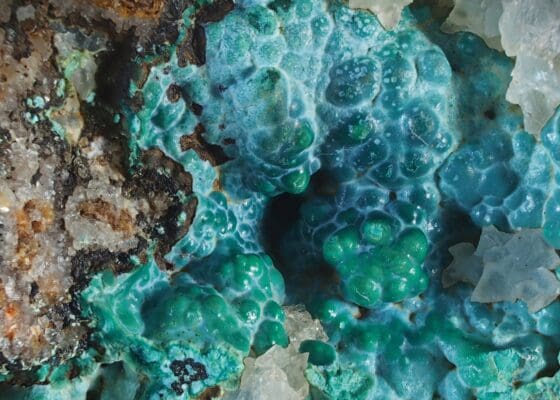
References and Further Reading
For those seeking to deepen their understanding of Chrysocolla, these sources offer valuable insights:
- The Mineralogical Society of America: Provides comprehensive information on Chrysocolla’s properties and geological formation.
- Gemological Institute of America (GIA): Offers detailed articles on Chrysocolla, including its identification and care.
Additionally, explore our website for internal links to related articles, enhancing your knowledge about gemstones and their unique qualities.

